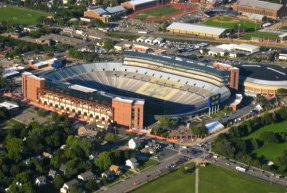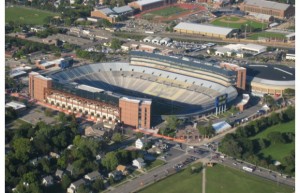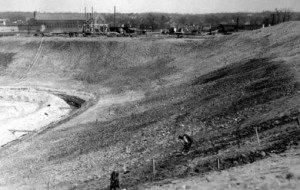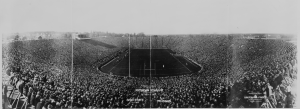#37. Michigan Stadium

Michigan Stadium dedication – 1927
Highlights from the big house dedication game against Ohio State.
 Michigan Stadium Location: Ann Arbor, MI Architect: Bernard Green Year: 1927
Michigan Stadium Location: Ann Arbor, MI Architect: Bernard Green Year: 1927
The big house was big when first completed in 1927, and in 2010, added seats brought capacity up to 113,000…yeah, crazy. The opening game of the season against the University of Connecticut realized an attendance of 113,090, the largest crowd ever assembled at a football game.
Michigan Stadium, nicknamed “The Big House,” is the football stadium for the University of Michigan in Ann Arbor, Michigan. Michigan Stadium was built in 1927 at a cost of $950,000 and had an original capacity of 82,000. Prior to the stadium’s construction, the Wolverines played football at Ferry Field. Michigan Stadium is the largest stadium in the United Stateswith an official capacity of 109,901, but has hosted crowds in excess of 115,000. It is the third largest stadium in the world and the 31st largest sports venue including auto racing and horse racing. The one “extra seat” in Michigan Stadium is said to be reserved for former athletic director Fritz Crisler, although its location is not specified. Every home game since November 8, 1975 has drawn a crowd in excess of 100,000, an active streak of more than 200 contests. On September 7, 2013, 115,109 attended a game at Michigan Stadium between Michigan and the Notre Dame Fighting Irish, making this the largest crowd to see a college football game since 1927 and setting an NCAA single-game attendance record, overtaking the 114,804 record set 2 years previously for the same match up.
Michigan Stadium was designed with footings to allow the stadium’s capacity to be expanded beyond 100,000. According to the University of Michigan Library’s and Athletics Department’s history of the stadium, Fielding Yost envisioned a day where 150,000 seats would be needed. To keep construction costs low at the time, the decision was made to build a smaller stadium than Yost envisioned but to include the footings for future expansion.
Michigan Stadium is the site of the University of Michigan’s main graduation ceremonies; renovations in April 2008 caused that year’s ceremony to be moved to the Diag. It has also hosted hockey games. On December 11, 2010, the “Cold War II”, a Michigan versus Michigan State hockey game, took place at Michigan Stadium. The event was officially called “The Big Chill at the Big House,” and over 100,000 tickets had been sold by May 6, 2010, when sales to the general public were stopped. The remaining seats were set aside for students. The attendance for the game was 104,073, smashing the previous record for a hockey game by nearly 25,000.
History – Early History
 Prior to playing at Michigan Stadium, Michigan played its games at Ferry Field, which at its peak could seat 40,000 people. Fielding Yost recognized the need for a larger stadium after original expansions to Ferry Field proved to be too small, and persuaded the regents to build a permanent stadium in 1926. Fashioned after the Yale Bowl, the original stadium was built with a capacity of 72,000. However, at Yost’s urging, temporary bleachers were added at the top of the stadium, increasing capacity to 82,000.
Prior to playing at Michigan Stadium, Michigan played its games at Ferry Field, which at its peak could seat 40,000 people. Fielding Yost recognized the need for a larger stadium after original expansions to Ferry Field proved to be too small, and persuaded the regents to build a permanent stadium in 1926. Fashioned after the Yale Bowl, the original stadium was built with a capacity of 72,000. However, at Yost’s urging, temporary bleachers were added at the top of the stadium, increasing capacity to 82,000.
 Formal dedication of the new Michigan Stadium, October 22, 1927, against Ohio State
Formal dedication of the new Michigan Stadium, October 22, 1927, against Ohio State
On October 1, 1927, Michigan played Ohio Wesleyan in the first game at Michigan Stadium, prevailing easily, 33–0. The new stadium was then formally dedicated three weeks later in a contest against Ohio State on October 22. Michigan had spoiled the formal dedication of Ohio Stadium in Columbus five years earlier and was victorious again, besting the Buckeyes 21–0 before a standing-room-only crowd of 84,401. In 1930, electronic scoreboards were installed, making the stadium the first in the United States to use them to keep the official game time.
In 1956, the addition of a press box raised the stadium’s official capacity to 101,001. The single extra seat above an even 101,000 was in honor of Fritz Crisler, athletic director at the time. Since then, all official Michigan Stadium capacity figures have ended in “-01.”
Before 1968, Michigan Stadium had a policy of “No women or children allowed on the field”. Sara Krulwich, now a photojournalist for The New York Times, was the first woman on the field. Longtime radio announcer Bob Ufer dubbed Michigan Stadium “The hole that Yost dug, Crisler paid for, Canham carpeted, and Schembechler fills every cotton-pickin’ Saturday afternoon.” Since November 8, 1975, the stadium has held over 100,000 fans for every home game. The game against Indiana University on October 25, 1975 was the last sub-100,000 attendance home game for Michigan. Michigan Stadium’s size is not wholly apparent from the outside; most of the seats are located below ground level.
Modern era
On September 9, 2006, attendees of Michigan’s football game against the Central Michigan Chippewas endured the first weather delay in the stadium’s history after lightning struck nearby during the first quarter. The game was delayed for approximately one hour. Michigan’s game versus Ball State University on November 4, 2006, was the 200th consecutive crowd of over 100,000 fans. Traditionally, when the game’s attendance is announced, the public address announcer (historically Howard King) thanks the fans for “being part of the largest crowd watching a football game anywhere in America today.” On September 3, 2011, Michigan and Western Michigan mutually agreed to end their game with 1:27 left in the third quarter because of an ongoing lightning delay. It was the first time Michigan had a football game called because of lightning. The stadium was evacuated at 6:38 p.m. and the game was called shortly after seven.
2010 renovation and beyond
 The new west side structure at Michigan Stadium, viewed from the southwest.
The new west side structure at Michigan Stadium, viewed from the southwest.
On June 21, 2007, the University’s Board of Regents approved a $226 million renovation and expansion project for Michigan Stadium. The project included replacement of some bleachers, widening of aisles and individual seats, installing hand rails, and the addition of a new press box, 83 luxury boxes, and 3,200 club seats. The renovation plan garnered opposition from students, alumni, and fans around the country, which waned as the renovation neared external completion. A disabled-veterans group filed a federal lawsuit against the university on April 17, 2007, alleging that the design of the project did not meet federal standards for wheelchair-accessible seating. On March 11, 2008, as part of the settlement terms of a lawsuit filed against the university pursuant to the Americans with Disabilities Act, the university announced that the official capacity of the stadium would be reduced to accommodate additional wheelchair-accessible seating beginning with the 2009 season. The project was completed before the 2010 season.
In August 2011 the University’s scoreboard replacement project was finished; the new boards measure 4,000 square feet each with a resolution of 900 x 1632.
Michigan Stadium was rededicated on September 4, 2010, before Michigan’s first home football game of the 2010 season against the University of Connecticut, with a listed capacity of 109,901. After the renovation, the stadium lacked permanent lights, although platforms for temporary lights were included in the design. In September 2010, a few days after the rededication, the University of Michigan’s Board of Regents approved a plan to add permanent lights, at a cost of $1.8 million. The lights were first used at the men’s hockey game on December 11, 2010. The following season saw the stadium’s first night football game on September 10, 2011. The Wolverines defeated the Notre Dame Fighting Irish 35–31.
The Michigan lacrosse program was elevated to NCAA varsity status in spring 2011, effective in the 2011-12 academic year. The team will play most of its 2012 games in Michigan Stadium, including a match against Ohio State on April 14, 2012, after the annual Wolverine football spring game.
Seating and surface
The stadium’s original capacity was 72,000, but Fielding Yost made certain to install footings that could allow for expansion up to 200,000 seats. Initially, all seating consisted of wooden bleachers. These were replaced with permanent metal seating in 1949 by Crisler, who was athletic director at the time. From 1927 to 1968, the stadium’s field was covered in natural grass. This was replaced with TartanTurf in 1969 to give players better traction. However, this surface was thought to be unforgiving on players’ joints, and the stadium returned to natural turf in 1991. This too became problematic, as the field’s below-surface location near the water table made it difficult for grass to permanently take root. The field was converted to FieldTurf, an artificial surface designed to give grass-like playing characteristics, in 2003. In 2010, it was upgraded with a brighter and higher quality version of field turf called Duraspine.
Attendance records
On September 7, 2013, Michigan Stadium drew its largest attendance for a football game to date. A crowd of 115,109 saw Michigan defeat Notre Dame, 41-30, setting a post-1948 NCAA collegiate football attendance record. A 1927 Notre Dame–USC game at Soldier Field in Chicago, prior to NCAA record keeping for attendance, drew an estimated 117,000–123,000. Michigan Stadium also holds the current NCAA single-season average home attendance record, which was set in 2011 at 112,179 fans per game and topped in 2012 at 112,252 fans per game.
With an attendance of 104,173, “The Big Chill at the Big House” set the record attendance for a hockey game. The previous record of 77,803 was set in the opening game of the 2010 IIHF World Championship on May 7, 2010 at Veltins-Arena, a retractable-roof soccer stadium in Gelsenkirchen, Germany.

